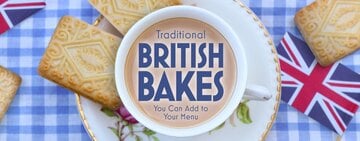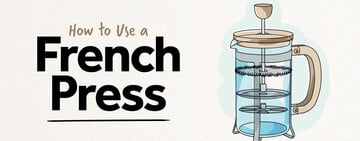Types of French Pastries
Hearing the words "French desserts" probably evokes thoughts of macarons, croissants, eclairs, or crepes. Rightfully, those desserts come to mind first. But there are even more French pastries to be explored that you may have never even heard of before! Whether you’re opening a bakery, planning a coffee and dessert menu, or just embracing the flavors of the world, we have a list of 12 French pastries to try out.
French Pastries List
Below is a list of French pastries that are worth adding to your baking roster:
1. Croquembouche
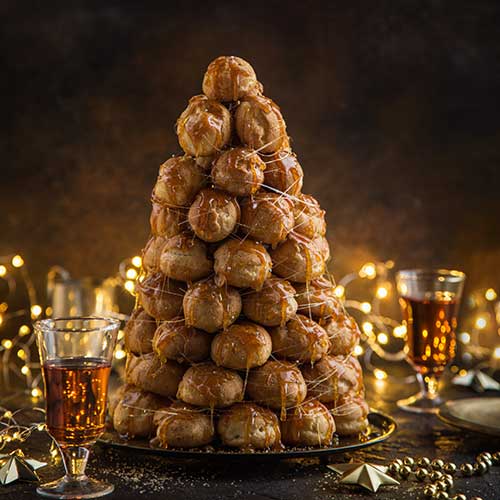
A croquembouche is a traditional wedding cake in France that is made up of cream puffs piled into the shape of a tower and bounded by caramel. The cream puffs are made from choux pastry and filled with cream. Each assembled cream puff is dipped in caramel and arranged on a croquembouche cone mold. The leftover caramel is then threaded around the croquembouche.
Further decoration with nuts, chocolate, and edible flowers has also been known to adorn a croquembouche. Because of its high-end look, a croquembouche is considered to be a “piece montee” (mounted piece), referring to a sculptural confectionary centerpiece for formal parties.
- Croquembouche Pronunciation: Croquembouche is pronounced “khro-kem-boosh”.
- Croquembouche History: Croquembouche is said to have been first created by Marie-Antoine Careme in the late 1700s. The croquembouche was first served to noblemen and other royals during this era but is now served at weddings, baptisms, and other formal gatherings in France.
What Is Choux Pastry?
Choux pastry, also known as pate a choux (pat-uh-shew), is a delicate and hollow pastry that's made from water and/or milk, butter, flour, and eggs. Choux pastry achieves its golden crispy shell and hollow center from the high moisture content creating steam inside the pastry and puffing it as it bakes. The choux pastry is then cooled and filled with various creams. Pate a choux dough is used when making famous French desserts such as croquembouche, Paris-Brest, eclairs, profiteroles, saint honores, and religieuses. Not just for French pastries, choux pastry dough is used to make Spanish churros.
Back to Top
2. Paris-Brest
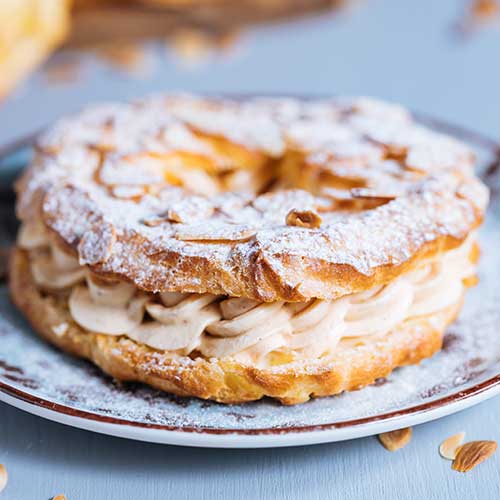
A Paris-Brest is an almond-studded, golden-baked pate a choux ring that has been sliced in half horizontally, decoratively filled with pastry cream, and dusted with powdered sugar. While Paris-Brest is traditionally filled with praline-flavored pastry cream (creme mousseline), you can use any flavored pastry cream or even whipped cream as the filling.
- Paris-Brest Pronunciation: Paris-Brest is pronounced “pah-ree brest”.
- Paris-Brest History: The history of the Paris-Brest dates back to 1910 when patissier Louis Durand of pastry shop Maisons-Laffitte was requested to make a dessert commemorating the Paris-Brest-Paris bicycle race. Durand shaped the Paris-Brest circularly to represent a bicycle wheel.
Back to Top
3. Entremet
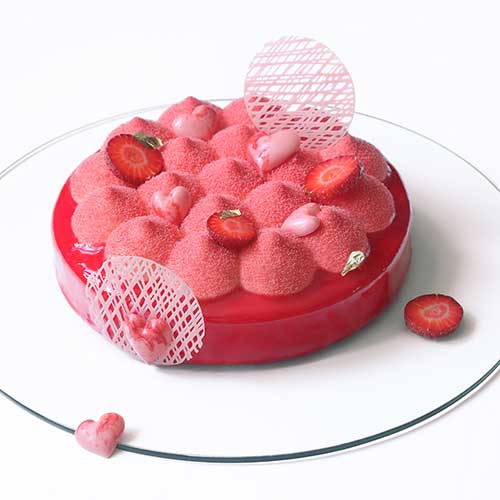
An entremet is a multi-layered cake that has an inner core of texturally contrasting layers wrapped in a mousse encasement and enrobed with a glaze or ganache. This modern French pastry can be decorated with isomalt sugar pieces, tempered chocolate, honeycomb, meringue, candied nuts, edible gold, or fresh fruit.
- Entremet Pronunciation: Entremet is pronounced “on-tra-may”.
- Entremet History: Entremet translates to “between courses” in old French, so entremets were historically small dishes served between lavish sit-down meals. In our modern-day, entremets are known as complex, sleek, and detailed cakes that are served in patisseries.
Back to Top
4. Clafoutis
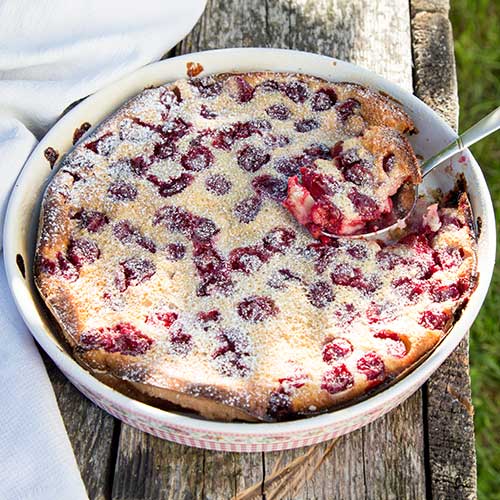
A clafoutis is a French dessert made with a thick, custard-like batter that’s poured over fruit and baked. The clafoutis turns into an airy, pudding-like texture and is then dusted with powdered sugar and often served with cream.
The fruit in a clafoutis is traditionally unpitted black cherries, but you can pit yours with a cherry pitter for easier eating. Other fruits such as figs, berries, and different stone fruits can be used in a clafoutis as well.
- Clafoutis Pronunciation: Clafoutis is pronounced “klah-foo-tee”.
- Clafoutis History: Clafoutis originated in the southwest countryside of Limousin, France. Clafoutis became very popular during the 19th century and soon became a well-known French dessert all over the country.
Back to Top
5. Gateau Opera
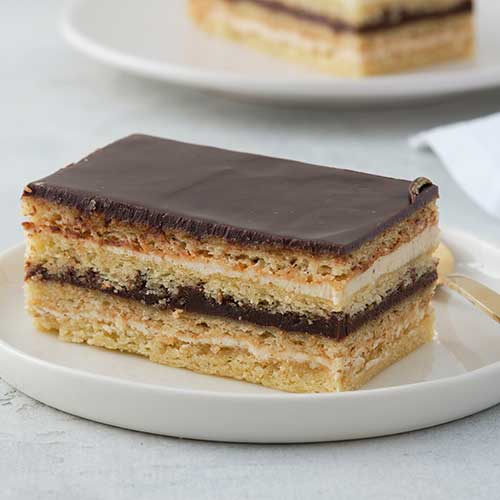
A gateau opera is a French dessert that’s made up of thin layers of joconde sponge (almond cake) brushed with coffee syrup or Grande Marnier, with additional layers of chocolate ganache and coffee buttercream. The final layer is chocolate ganache that traditionally has “Opera” written in cursive.
- Gateau Opera Pronunciation: Gateau opera is pronounced “ghat-toe ohp-ehr-a”
- Gateau Opera History: The history of the gateau opera has conflicting origins, but the most accepted origin is the gateau opera’s invention in 1955 by Parisian pastry chef Cyriaque Gavillon at the famous Parisian patisserie Dalloyau.
Back to Top
6. Mille Feuille
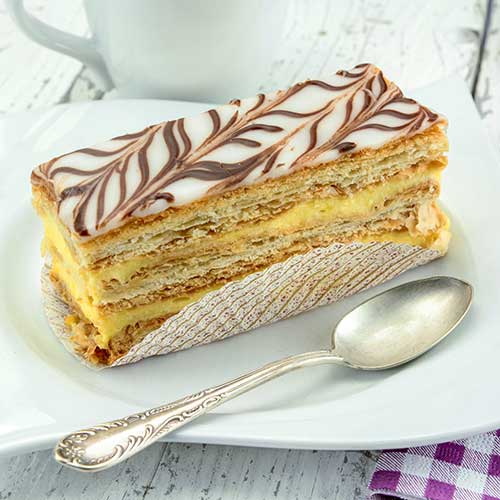
Mille feuille is a French dessert that has three sections of alternating layers of flaky puff pastry and stabilized cream filling. It’s finished with vanilla royal icing and combed with chocolate ganache.
Mille feuille means “one thousand sheets” in French, referring to the three sections of numerous layers of laminated puff pastry. Mille feuille is also known as a napoleon, although a napoleon traditionally uses almond cream instead of pastry cream.
- Mille Feuille Pronunciation: Mille feuille is pronounced “meel foy”.
- Mille Feuille History: Mille feuille was first introduced by chef Francois Pierre de la Varenne in Le Cuisinier Francois, one of the earliest French cookbooks. In its 1651 publish date, mille feuille originally used bechamel sauce (one of the five mother sauces) and was later changed by Marie-Antoine Careme to use a sweet cream as the filling.
Back to Top
7. Canele
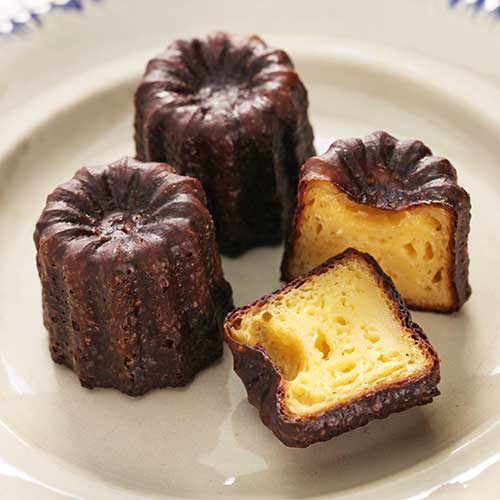
A canele is a bread pudding-like French pastry with a deeply caramelized outer crust and a densely rich, tender-crumbed center. It’s flavored with vanilla and rum and baked in specially fluted canele molds. These molds bake the caneles to ensure the dark Maillard browning effect on the crust while maintaining the desirable, dense custardy interior.
- Canele Pronunciation: Canele is pronounced “kahn-eh-lay”.
- Canele History: While their origins remain disputed, it is commonly accepted that caneles were invented some time during the 15th and 18th centuries in Bordeaux.
Back to Top
8. Tarte Tatin
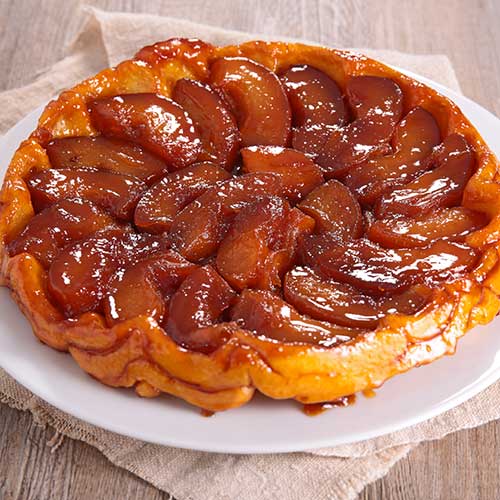
A tarte Tatin is an apple tart that consists of deeply caramelized apples and a flaky pastry crust. This French dessert is famously baked upside-down for the ultimate caramelization and so the apples are arranged in an organized pattern. When tarte Tatin comes out of the oven, it is inverted right-side-up to expose the confit-like apples that are now nestled in a buttery-brown pastry crust.
- Tarte Tatin Pronunciation: Tarte Tatin is pronounced “tahrt tah-tahn”.
- Tarte Tatin History: Tarte Tatin is said to be created by French sisters Carolina and Stephanie Tatin at their hotel in Lamotte-Beuvron. It’s believed that it was made accidentally by the overworked sisters, who either baked the tart upside-down by mistake or incorrectly followed an apple pie recipe.
Back to Top
9. Petit Fours
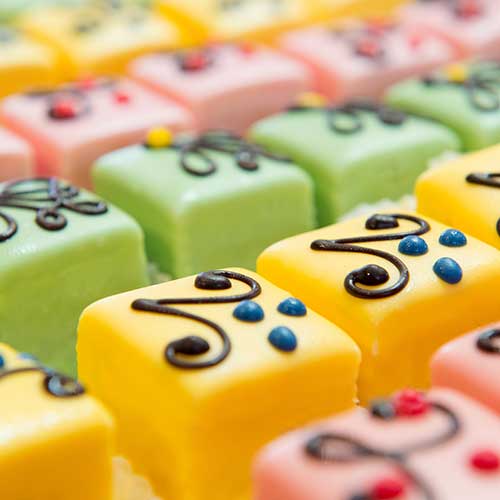
Petits fours are small tea cakes in various flavors that are frosted and decorated. Petit fours translate to “small oven” in French and are also sometimes known as mignardises.
Petits fours are usually recognized as sweet French desserts, but they can be made into a savory version. Sweet petits fours are very common at tea parties, weddings, and bridal showers.
- Petit Fours Pronunciation: Petit fours is pronounced “puh-tee fohr”
- Petit Fours History: Petits fours were first made in 18th century France when bakeries solely used large brick ovens. Because these ovens were not temperature controlled, the ovens would get to blazing hot temperatures which were perfect for baking bread. During the cool-down period after the bread was finished, bakers would utilize this leftover oven heat to bake more delicate desserts, one of them being the cake in petits fours.
Back to Top
10. Souffle
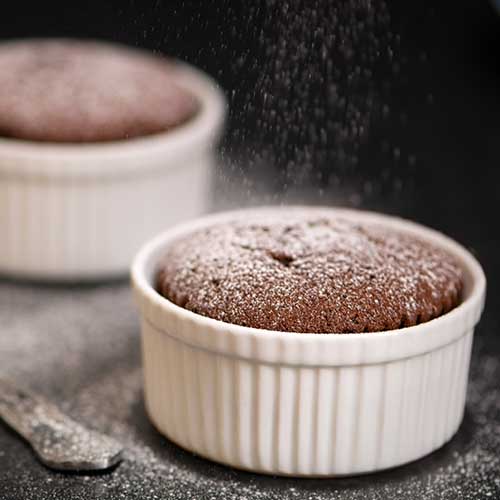
A souffle is a light and airy baked egg dish that can be made either sweet or savory. Souffles are more commonly thought of as a French dessert, with the most popular sweet souffle flavor being chocolate.
Because souffles are so versatile with their flavoring options, there are many more sweet souffle options that can be used as a French dessert. Lemon souffle, raspberry souffle, and Grand Marnier souffle are very popular flavors. The most popular savory souffle flavors are cheese souffles, spinach souffles, and chicken souffles.
- Souffle Pronunciation: Souffle is pronounced “soof-lay”.
- Souffle History: There are many different accreditations of who first invented the souffle. Some say it was first made by Vincent de la Chappelle in the 1700s. The next accreditation is Antoine Beauvillers, who wrote in detail about souffles in his 1814 cookbook “L’Art Du Cuisinier”. However, many people look to Marie-Antoine Careme as the chef that truly developed and popularized this iconic French dessert.
Back to Top
11. Creme Brulee
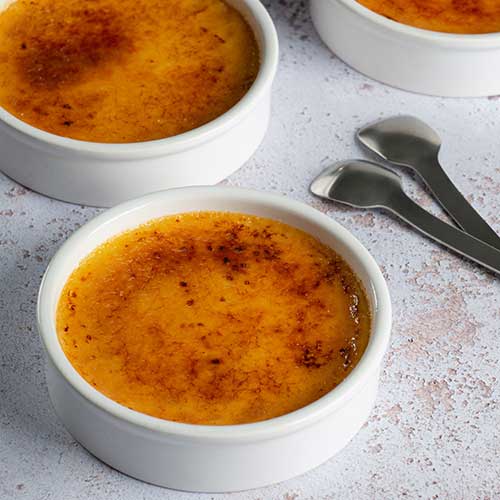
A creme brulee is a baked custard dish with a top layer of caramelized sugar. The custard base is traditionally baked in a ramekin and stored in the refrigerator so the custard is chilled before service. The hard sugar topping is caramelized on the custard using a butane torch or salamander just before serving.
This French dessert usually uses a type of vanilla, but many restaurants and chefs have used specialty ingredients to give creme brulee their own spin. From matcha and Kona coffee to ruby chocolate and pumpkin creme brulee, there are so many options to make one that’s unique to your menu.
- Creme Brulee Pronunciation: Creme brulee is pronounced “krehm broo-lay”.
- Creme Brulee History: The history of creme brulee is a widely debated topic in the food world. Currently, the earliest known recording of the recipe is in Francois Massialot’s 1691 cookbook “Cuisinier Royal et Bourgeois”, but many believe creme brulee was made far before that in the 14th century.
Back to Top
12. Fraisier
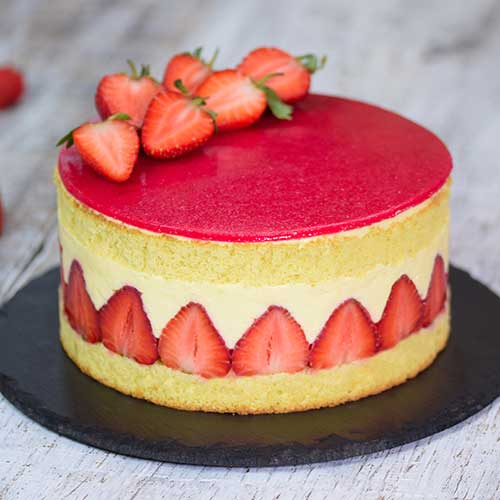
A fraisier is a summertime French dessert that is made from strawberries, genoise sponge cake, mousseline cream, and marzipan. Strawberry translated in French is “fraises”, which is where the name for this cake comes from.
A fraisier is typically built with a genoise sponge on the bottom, halved strawberries lining the outside and inside, topped with mousseline cream, and topped again with a second layer of genoise sponge. It is finished with marzipan but can be dusted with powdered sugar or a small layer of more mousseline cream.
- Fraisier Pronunciation: Fraisier is pronounced “frez-yay”
- Fraisier History: The origin of the fraisier cake is mostly unknown. Some date the fraisier cake to the 1860s, while others guess the 1930s.
Back to Top
French cuisine has a rich history with even richer dishes to be explored. Next time you’re planning a new menu, keep in mind this list of French pastries for your dessert section. Don’t forget to practice the pronunciations!

